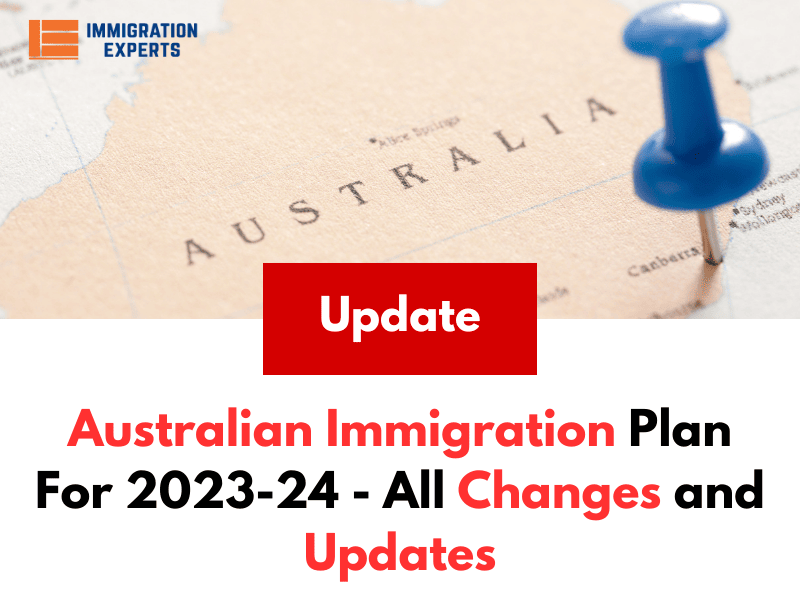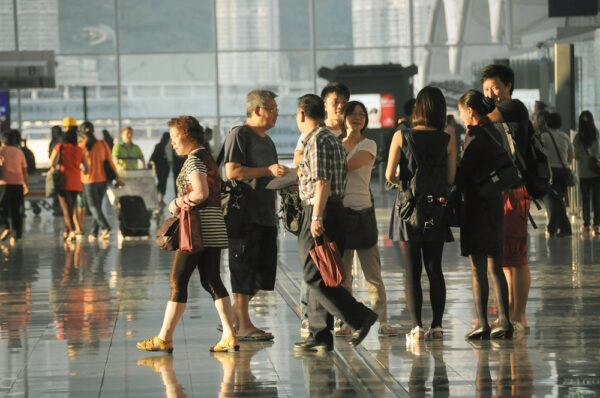051 8439995, 042 35911332

The Australian Government has recently unveiled its Migration Program planning levels for the year 2023-24 on 9 May 2023, with a commitment to allocate 190,000 places. This initiative aims to address persistent skills shortages and attract individuals possessing specialized skill sets that are in high demand but scarce within the country.
Supporting Economic Growth and Resilience
The 2023-24 Permanent Migration Program is strategically designed to bolster Australia’s workforce in critical areas. While the nation is actively developing its pool of highly skilled workers, this program will play a pivotal role in:
1. Building Resilience: By infusing the labor market with skilled professionals, the program enhances the nation’s resilience in the face of economic challenges.
2. Boosting Productivity: Skilled migrants significantly contribute to increased productivity in various industries, ultimately driving economic growth.
3. Facilitating the Transition to Net-Zero Emissions: As Australia transitions toward net-zero emissions, the program supports this transition by attracting talent in sustainable industries.
Migration Program 2023 – 24 Composition

The 2023-24 Permanent Migration Program is structured into three main streams:
1. Skill Stream (137,100 places): This stream constitutes approximately 72 percent of the program and is dedicated to enhancing the country’s productive capacity. It addresses skill shortages in the labor market, with a specific focus on regional areas.
2. Family Stream (52,500 places): Comprising around 28 percent of the program, the Family Stream primarily includes Partner visas. These visas enable Australians to reunite with their family members from overseas and provide them with pathways to citizenship. It’s noteworthy that 40,500 Partner visas and 3,000 Child visas are estimated for 2023-24 for planning purposes, with flexibility to meet demand.
3. Special Eligibility Stream (400 places): This stream caters to individuals in unique circumstances, including permanent residents returning to Australia after residing overseas.
Comparison Between 2022-23 and 2023-24 Migration Planning Levels
The Australian Government’s Migration Program is an ever-evolving initiative that adapts to the nation’s changing needs. Let’s compare the planning levels for the 2022-23 and 2023-24 programs, shedding light on the adjustments made.
Skill Stream:
- Employer Sponsored: In 2022-23, 35,000 places were allocated, while in 2023-24, it’s set to increase to 36,825. This category aims to address skill needs within specific employment sectors.
- Skilled Independent: The planning level has decreased slightly from 32,100 in 2022-23 to 30,375 in 2023-24. This visa category targets individuals with in-demand skills.
- Regional: In 2022-23, 34,000 places were designated for regional visas, while 32,300 places are planned for 2023-24. These visas encourage settlement and employment in regional areas.
- State/Territory Nominated: The planning level has reduced from 31,000 places in 2022-23 to 30,400 in 2023-24. These visas support state and territory-specific skill requirements.
- Business Innovation & Investment: A significant decrease is observed, with planning levels dropping from 5,000 places in 2022-23 to 1,900 in 2023-24. These visas attract business and investment talent.
- Global Talent (Independent): This category maintains a steady 5,000 planning level for both years, attracting international talents with exceptional skills.
- Distinguished Talent: The planning level remains unchanged at 300 places. This visa is reserved for individuals with outstanding accomplishments in specific fields.
Skill Total: In the skill stream, the total planning level has decreased slightly from 142,400 places in 2022-23 to 137,100 in 2023-24, reflecting adjustments in various categories.
Family Stream:
- Partner: Both years maintain the same planning level of 40,500 places, reflecting the importance of family reunification.
- Parent: This category also remains consistent, with 8,500 places allocated in both 2022-23 and 2023-24, allowing parents to join their children in Australia.
- Child: A stable planning level of 3,000 places is maintained for child visas in both years, emphasizing the value of family bonds.
- Other Family: This category retains its planning level of 500 places in both years.
Family Total: The family stream maintains a steady planning level of 52,500 places in both 2022-23 and 2023-24, underscoring the government’s commitment to family reunification.
Special Eligibility: The planning level for this stream has increased from 100 places in 2022-23 to 400 places in 2023-24. These visas cater to individuals with special circumstances, such as returning permanent residents.
Total Migration Program: In summary, the overall Migration Program planning level has seen a slight reduction, moving from 195,000 places in 2022-23 to 190,000 places in 2023-24. These adjustments reflect the government’s ongoing efforts to align the program with evolving economic and demographic needs.

Please keep in mind that the planning levels for Partner and Child visas are determined by demand, with suggested planning levels acting as guidelines.
State and Territory Nominated Visa Categories
Within the Australian Migration Program 2023 – 24, states and territories have a key role in addressing specific regional needs. They can nominate individuals for the following visa categories:
- Skilled – Nominated (Subclass 190)
- Skilled Work Regional (Provisional) (Subclass 491)
- Business Innovation and Investment Program (BIIP)
States and territories nominate individuals for these visas based on their assessment of local skills shortages and economic priorities.
If you’re interested in the specific nomination requirements for each state and territory within Australia, you can find detailed information at the following official websites:
- ACT – Migration: For information about the nomination process and requirements in the Australian Capital Territory, visit their official migration website.
- NSW – Visas and Immigration: New South Wales provides information on visas and immigration, including their nomination requirements.
- VIC – Live in Melbourne: Victoria, with its vibrant city of Melbourne, offers details on living and working in the state, including visa nomination specifics.
- QLD – Business & Skilled Migration Queensland: Queensland provides comprehensive information on business and skilled migration opportunities, along with nomination requirements.
- NT – Migrate: The Northern Territory offers resources for migrants, including details on their nomination program.
- WA – Business Migration Western Australia (BIIP) or Skilled Migration Western Australia (190 and 491 visas): Western Australia has dedicated websites for both business migration and skilled migration, with information on their respective nomination requirements.
- SA – Move to South Australia: South Australia provides insights into moving to and working in the state, along with nomination requirements.
- TAS – Migration Tasmania: Tasmania offers resources for migrants, including information on their nomination program.
Understanding What is the Allocation of State and Territory Nominations for 2023–24 Means
Nomination allocations signify the number of new primary applicants that each state or territory can nominate within a program year. These allocations are distinct from the total number of visa applicants and do not impose limitations on the number of visas that can be granted in these categories.
New applications are added to the existing on-hand caseload in various visa categories. This means that the allocation process considers both new nominations and applications that are already in the system.
The Department processes both existing applications and new nominations from states and territories in line with the permanent Migration Program’s planning levels and the priorities set for skilled visa processing.
State and Territory Nomination Allocations for 2023–24

In the 2023–24 migration program, state and territory governments have allocated nominations for various visa categories, with a focus on skilled migration and regional development. Here is a breakdown of the nomination allocations:
Skilled Nominated (Subclass 190) Visa:
- ACT (Australian Capital Territory): 600 nominations have been allocated for this visa category.
- NSW (New South Wales): 2,650 nominations have been allocated.
- NT (Northern Territory): 250 nominations have been allocated.
- QLD (Queensland): 900 nominations have been allocated.
- SA (South Australia): 1,100 nominations have been allocated.
- TAS (Tasmania): 600 nominations have been allocated.
- VIC (Victoria): 2,700 nominations have been allocated.
- WA (Western Australia): 1,500 nominations.
For the 2023–24 program year, a total of 10,300 nominations have been designated for the State and Territory Nominated (Subclass 190) visa.
Skilled Work Regional (Subclass 491) Visa:
- ACT (Australian Capital Territory): 600 nominations have been allocated for this regional visa.
- NSW (New South Wales): 1,500 nominations.
- NT (Northern Territory): 400 nominations have been allocated.
- QLD (Queensland): 650 nominations.
- SA (South Australia): 1,200 nominations have been allocated.
- TAS (Tasmania): 600 nominations.
- VIC (Victoria): 600 nominations have been allocated.
For the 2023–24 program year, the Skilled Work Regional (Subclass 491) visa receives a total of 6,400 nominations.
Business Innovation and Investment Program (BIIP):
For the BIIP category, no new allocations have been made for the 2023–24 program year. The Department indicates that there are sufficient applications on hand to meet the planning level for the BIIP for this period.
Delivery of the 2023–24 Migration Program
The Australian Government is taking steps to manage visa processing efficiently for the 2023–24 Migration Program. This includes funding for 500 more visa processing officers, amounting to $48.1 million over a year. Additional trained staff and a $27.8 million investment in visa ICT systems are also enhancing processing capacity and efficiency. These measures aim to make Australia more attractive to global talent, students, and tourists.
✅Subscribe to our YouTube Channel and Facebook Page to get the latest updates on Immigration, Student Visas, Visit Visas, and Online Businesses.
⭕ www.youtube.com/rizwanulhaque22
⭕ www.facebook.com/rizwanulhaque22
